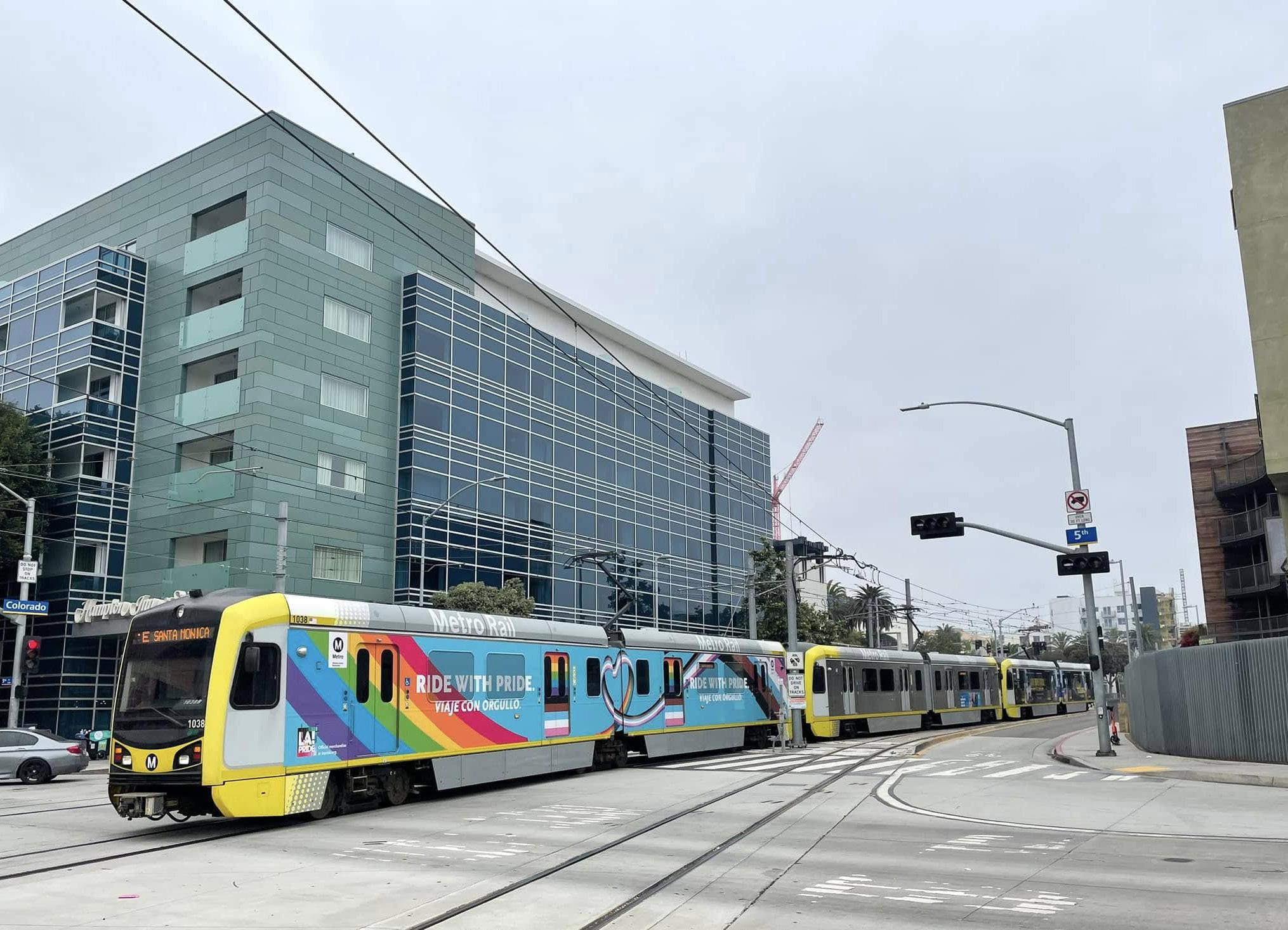
Santa Monica Secures Nearly $1M to Expand Neighborhood Greenway Projects



Santa Monica Secures Nearly $1M to Expand Neighborhood Greenway Projects

The decision follows months of discussion, beginning with a March 11 meeting where the council explored ways to balance efficiency with public input
The Santa Monica City Council voted 6-1 on May 27 to adopt a resolution amending its Rules of Order and Procedure, discontinuing the practice of time donation for public comment and introducing new speaking time limits to enhance meeting efficiency. The changes took effect immediately.
Under the revised rules, members of the
public are allotted a total of six minutes per meeting for public comment. Speakers addressing multiple agenda items can divide their time in one-minute increments, with a maximum of two minutes per item. Those speaking on a single item may use up to four minutes for that item. The previous practice of donating unused speaking time to other speakers was eliminated to address concerns about prolonged meetings and inequities in public participation.
The resolution also includes additional procedural updates: the mayor will now report on closed session matters involving the city manager, city attorney, and city clerk; agendas for special meetings must be delivered to council members at least 24 hours in advance; and quasi-judicial items are exempt from consolidated public comment periods. Other changes involve clarifying motion procedures and removing redundant rules on debate limits.
Council Member Ellis Raskin was the sole dissenter, expressing concerns over the elimination of time donations and the restructuring of public participation. The decision follows months of discussion,

and directed staff to draft the final language.
Both encouraged residents to access resources, including the Los Angeles County Office of Immigrant Affairs and the city’s Safe at Home page
The mayor of Santa Monica and the superintendent of the Santa MonicaMalibu Unified School District issued statements Monday addressing community concerns over reported Immigration and Customs Enforcement activity in the greater Los Angeles area, emphasizing their commitment to protecting all residents regardless of immigration status.
Mayor Lana Negrete acknowledged
the “anxiety and fear” felt by immigrant communities following heightened immigration enforcement across Los Angeles. In a statement released at 2:03 p.m., she reiterated the city’s 2016 resolution, reaffirmed in December 2024, to protect all residents. “Santa Monica does not and will not assist federal immigration authorities in enforcing immigration laws,” Negrete said, citing compliance with California’s SB54, the California Values Act of 2017, which limits local cooperation with federal immigration enforcement to cases involving criminal arrests.
Negrete also addressed concerns about potential unrest, referencing past incidents like the May 31, 2020, protests and the January 2025 wildfires. The Santa Monica Police Department (SMPD) has increased staffing to monitor for enforcement activities or protests, she said, while stressing that the city respects the right to peaceful protest. “Individuals taking advantage of the situation to loot or vandalize within our city will be subject to arrest and prosecuted to the fullest extent
of the law,” she added.
In a separate letter to parents, guardians, staff, students, and community members, SMMUSD Superintendent Dr. Antonio Shelton sought to quell rumors of ICE patrols near schools. “As of 2:30 p.m. today, these sightings have not been confirmed, and we can assure you that ICE officials are not currently present in or at our schools,” Shelton wrote. He noted that the district is in direct communication with city officials and the SMPD to monitor the situation.
Shelton emphasized that SMMUSD schools are “safe spaces” where ICE cannot enter without a proper warrant, and district staff have been reminded of relevant protocols. The district’s Immigration Support & Resources webpage offers information on rights and support for families. “We remain committed to supporting and serving every single one of our families, regardless of immigration status,” Shelton said, underscoring the district’s core values of mutual respect, dignity, and fairness.

Both officials encouraged residents to access resources, including the Los Angeles County Office of Immigrant Affairs and the city’s Safe at Home page, to understand their rights. The city and school district are collaborating with civil rights organizations, legal aid attorneys, and immigration advocates to support vulnerable residents.

Better is a state-of-the-art gym to build a stronger brain.
The FitBrainSM gym at Saint John’s is pioneering treatments in brain fitness by using innovative technology to gamify physical and cognitive tasks, improving mind-body connection and helping to prevent or slow down the effects of dementia and Alzheimer’s disease. Sessions at the FitBrain gym are tailored to each patient’s individual goals and have been shown to positively impact processing speed and executive functions, as well as enhance balance and mood. It’s just one of the many ways we treat you for the better.























In response to the devastating January 2025 wildfires, a coalition of local arts and conservation groups will host a free Fire Recovery Conservation Clinic on Saturday, June 14, at the Getty Center in West Los Angeles.
The event, running from 11:00 a.m. to 3:00 p.m. on the Getty’s Center Campus, is the third in a series of public recovery efforts aimed at helping Southern California residents salvage artworks and cherished personal items damaged by fire, smoke, and ash. Previous clinics were held at the Armory Center for the Arts in Pasadena and MOCA Geffen in downtown Los Angeles.
Organized in partnership with the Los
Angeles County Department of Arts and Culture, Getty, and Art Recovery LA, the clinic will offer on-site services including professional condition assessments, soot and ash removal, and demonstrations of at-home cleaning and odor-remediation techniques. Conservation professionals will also create custom archival storage boxes to help preserve salvaged items.
Residents are invited to bring up to three small items or one larger object (no larger than 30 inches in its longest dimension). Acceptable items include photographs, albums, toys, textiles, ceramics, jewelry, stuffed animals, and other sentimental belongings that survived the fires.
Attendees must reserve a free ticket in advance, which will also serve as admission to the Getty Center. Parking will be validated at no charge for clinic participants. Directions and event details will be provided to registered guests. You can reserve your ticket here.
For questions or additional information, the clinic’s support line is open daily from 9 a.m. to 5 p.m. at (310) 440-7300.


The 36-month project, set to begin this summer, includes community engagement through pop-ups, walk audits, and a citywide survey
Santa Monica has been awarded an $875,552 grant from the Southern California Association of Governments to enhance its Neighborhood Greenways project, city officials announced. The funding, approved by the City Council on April 8 will support safety and mobility improvements along Michigan Avenue and establish a new greenway on Washington Avenue.
The grant, part of SCAG’s 2024 Sustainable Communities Program – Active Transportation and Safety, will fund quick-build projects using low-cost, durable materials like paint, bollards, and signage to test safety enhancements for pedestrians, cyclists, and transit users. Quick-build projects allow rapid implementation and community feedback before permanent infrastructure is installed.
The Michigan Avenue Neighborhood Greenway (MANGo), launched in 2017, will see upgrades to traffic

calming measures, including potential replacements for worn devices. The project builds on prior improvements, such as traffic circles and a 2024 bike and pedestrian connection to the Bergamot Arts Center over the I-10 freeway. Local residents, including Pico neighborhood families and Santa Monica High School students, have reported increased congestion from cutthrough traffic, prompting the need for further enhancements.
Washington Avenue, a key corridor linking Northeast and Wilmont neighborhoods, will receive its first neighborhood greenway treatment. The corridor serves Franklin Elementary, Lincoln Middle School, and other community hubs but currently lacks robust safety features despite high participation in walking and biking programs, with 87% and 64% of students at Franklin and Lincoln, respectively, engaging in Bike it! Walk it! events since 2022.
The 36-month project, set to begin this summer, includes community engagement through pop-ups, walk audits, and a citywide survey, alongside data collection and evaluation. SCAG will manage consultant procurement, while the city oversees construction, expected to start in summer or fall 2026.
The project is exempt from the California Environmental Quality Act under Section 15301, as it involves minor roadway alterations like curb extensions, diverters, and improved crosswalks without expanding vehicle capacity.
Santa Monica’s initiative was one of 11 quick-build projects selected from

21 applications evaluated by SCAG, which awarded $8.2 million regionwide.
The city’s success has spurred local Assemblymember efforts to expand
strategies to state highways, reflecting growing support for rapid, community-driven infrastructure improvements.




The proposed amendments, officials say, will boost the local cannabis industry while addressing social equity concerns
The Santa Monica Planning Commission is advancing a bold overhaul of the city’s cannabis zoning regulations, set to allow retail marijuana sales across all non-residential districts starting in 2025.
The proposed amendments, currently under review, aim to streamline the permitting process by eliminating discretionary reviews, a move officials say will boost the local cannabis industry while addressing social equity concerns.
The initiative, detailed in a draft ordinance released this week, responds
to
evolving state laws and growing demand for legal marijuana sales. If approved by the City Council, the changes would permit cannabis retailers to operate in commercial and mixeduse zones without the lengthy approval processes that have historically delayed applications. The proposal also introduces a social equity program, targeting individuals and communities disproportionately affected by past cannabis-related criminalization.
Eligibility for the program hinges on criteria such as prior marijuana-related arrests or residency in economically disadvantaged areas. City officials emphasized that the initiative aligns with California’s broader push to rectify the social and economic impacts of the war on drugs.
Santa Monica’s move follows a trend among California cities rethinking cannabis regulations post-legalization. The city currently hosts a limited number of licensed dispensaries, but the new ordinance could double that figure within two years, according to city projections. Officials are also exploring caps on store numbers and mandatory security measures to address public safety concerns.



Santa Monica Architects for a Responsible Tomorrow
California’s ambitious housing mandates were supposed to solve the affordability crisis. Instead, they’re creating a vicious cycle that’s killing public transit and pushing working families further from opportunity. New UCLA research reveals a stunning pattern: every $230 increase in monthly rent predicts a 22% drop in bus and train ridership. This isn’t coincidence—it’s displacement economics in action.
California’s RHNA housing production targets pressure cities to approve development wherever they can. But it’s not just large-scale apartment buildings—state lot-split laws like SB 9 are quietly transforming single-family neighborhoods within half a mile of transit stops.
These laws allow property owners to divide single-family lots into multiple parcels, creating duplexes and small multi-family buildings in previously single-family zones. Marketed as “gentle density,” the reality is more complex:
these new units command market rates (there are no affordability requirements for small splits) that attract affluent residents who often drive rather than use nearby transit.
It is a cruel irony that State mandates designed to create affordability are instead creating a transit accessibility crisis at multiple scales. When developers build near train stations without affordability requirements—whether large apartments or subdivided lots— they’re reconstructing neighborhoods. Lower-income families who depend on buses and trains get pushed to cardependent suburbs, while affluent newcomers drive to work from their transit-adjacent homes.
As ridership declines, transit agencies face cascading problems that create their own death spiral:
Reduced Revenue and Service Cuts: Lower ridership means less fare revenue, forcing agencies to cut service frequency and routes. Metro’s recent service reductions exemplify this vicious cycle— fewer buses and trains mean longer waits, driving away even more riders.
Security and Safety Deterioration: Emptier trains and platforms create environments where crime and antisocial

Immerse yourself in a sanctuary where nature’s tranquility meets the vibrancy of city life. Urban Jungle is more than a plant store it’s a communitycentered oasis bringing a lush slice of paradise to your urban lifestyle. Here, we passionately believe in the power of plants to transform spaces and elevate well-being.


behavior flourish. Well-documented safety issues on Metro lines have made transit systems unwelcoming to families. When middle-class riders abandon transit due to safety concerns, the remaining ridership becomes increasingly concentrated among those with no alternatives, creating a perception of transit as social service rather than transportation infrastructure.
Political Support Erosion: As ridership demographics shift and affluent communities increasingly see transit as “not for them,” political support for transit funding wanes. Voters who drive to work from their transit-adjacent homes are less likely to support bond measures for system improvements.
Deferred Maintenance: Reduced ridership and political support lead to deferred maintenance and cancelled expansion projects. Aging infrastructure becomes less reliable, further deterring potential riders.
Cities face perverse incentives in this system. Santa Monica teeters on bankruptcy despite being surrounded by wealth, desperately needing more taxable residential properties to shore up finances. Cities can’t afford to say no to market-rate development, even when






it undermines their transit systems and community character.
This creates a destructive feedback loop: financial desperation drives cities to approve exactly the kind of development that destroys their transit ridership base. Cities become addicted to tax revenue from high-end housing, even as that housing pushes out working families who actually use public transportation. State housing mandates exploit this municipal vulnerability, forcing financially strapped cities to choose between fiscal survival and preserving transit-dependent communities.
Sacramento Democrats are trapped between two visions:
Team Build-More: Led by Senator Scott Wiener, argues that increasing housing supply—even market-rate—will eventually ease pressure on everyone.
Team Affordable-First: Warns that building without affordability requirements accelerates displacement of people who need transit most.
Wiener’s SB 79 would supercharge development around transit stops, including on transit agency land. But critics see it as “gentrification by legislative mandate”—using state power to transform neighborhoods without protecting existing residents.
This isn’t just about housing or transit—it’s about environmental justice and California’s climate goals. When displaced transit riders are forced into car-dependent suburbs, environmental impacts multiply:
• Former transit users now driving from distant suburbs create more traffic, emissions, and infrastructure strain. Each displaced family might add 20,000+ vehicle miles annually.
• Working families pushed to Riverside, San Bernardino, and Central Valley communities increase development pressure in previously undeveloped areas, destroying habitat and agricultural land.
• California cannot meet aggressive climate targets while pursuing housing policies that increase car dependency.
The suburbanization of poverty isn’t a natural market force—it’s a policy choice. Every time California prioritizes housing production over housing affordability near transit, it chooses to push working families away from jobs, services, and mobility options.
The solution isn’t abandoning housing production—California desperately needs more homes. But mandating quantity while hoping for affordability isn’t working. Real reform requires: Affordability by Design: State mandates that tie development rights to affordability requirements. No transitadjacent development should proceed without guaranteeing units for existing community income levels.
Anti-Displacement Protection: Policies helping existing residents stay as neighborhoods improve, including community land trusts, tenant protections, and local hiring requirements for new
developments.
Transit-First Development: Housing policies that prioritize keeping transit riders near transit, with dedicated funding for affordable housing within transit corridors.
Transit Security and Service Investment: Addressing safety concerns through improved lighting, security presence, and social services while maintaining frequent, reliable service that attracts choice riders.
Regional Coordination: Aligning housing, transportation, and economic development policies across regions to prevent geographic sorting that undermines both equity and efficiency.
California spends billions on transit systems while inadvertently destroying their ridership base through housing policy. It’s uniquely Californian governmental self-sabotage: solving one crisis by creating another.
Every transit-adjacent apartment that displaces a bus rider is a small defeat for both affordability and sustainability. Every working family pushed to a cardependent suburb represents integrated planning failure. Every empty train car during rush hour is evidence that California’s approach isn’t working.
The bottom line is that California’s housing mandates aren’t just failing to create affordability—they’re actively destroying transit systems that make carfree living possible. From lot splits in single-family neighborhoods to luxury apartments on transit agency land, state policy systematically replaces transit riders with car drivers. Meanwhile, financially desperate cities like Santa Monica become unwilling accomplices, approving development they know will undermine their communities because they need tax revenue to survive.
The resulting transit death spiral— declining ridership leading to service cuts, safety problems, and political abandonment—threatens decades of investment in sustainable transportation infrastructure. Until Sacramento aligns its housing, transportation, and municipal finance policies, this expensive, environmentally destructive spiral will continue—with each new market-rate unit near transit representing another small victory for cars over trains.
Jack Hillbrand, AIA, Landmarks Commission Architect
Santa Monica Architects for a Responsible Tomorrow
Samuel Tolkin, Architect & Planning Commissioner; Thane Roberts, Architect; Mario Fonda-Bonardi AIA, Architect (ex-Planning Commissioner); Robert H. Taylor AIA, Architect; Dan Jansenson, Architect & Building and Fire-Life Safety Commission; Michael Jolly, AIRCRE; Jack Hillbrand, AIA, Architect, Landmarks Commissioner; Matt Hoefler NCARB, Architect; Phil Brock, SM Mayor (ret)
• Accessory Dwelling Unit
• Additions
• Complete Remodel
• Kitchen
For previous articles, see www. santamonicaarch.wordpress.com/writing


• Bathroom Honesty, Value, and Quality Are The Standard
• Construction services
• Consultation
• Design Conceptualization
• Design Development
• Architectural Plans
• Engineering
• Permit Acquisition
General Contractor License #1070134 FREE

Create Construction is a boutique design and remodeling company serving Los Angeles, Orange, and Ventura counties. We’ll create the home you’ve always envisioned, using our expertise and dedication to quality craftsmanship. Call now to begin the collaborative process of building your dream home.


Iconic Oceanfront Steakhouse Returns With Its Beloved Butter Cake, Nightly Live Music, and Sunset Glamour
After a five-month closure due to the Palisades Fire, Mastro’s Ocean Club in Malibu has officially reopened its doors as of May 31, once again offering guests signature steaks, chilled seafood towers, handcrafted cocktails, and sweeping ocean views. The upscale dining destination, located at 18412 Pacific Coast Highway, is now welcoming patrons daily starting at 4:00 p.m.
Bar service begins at 4 p.m. every day. Dining hours are:
• Sunday–Thursday: 4:00 p.m. to 9:00 p.m.
• Friday–Saturday: 4:00 p.m. to 10:00 p.m.
To discuss the reopening and what diners can expect, Dolores Quintana spoke with Patrick Barrett, divisional vice president for Mastro’s Restaurants, who has been with the company for nearly two decades.
Dolores Quintana: Can you share a little about your background and connection to the Malibu location?
Patrick Barrett: Absolutely. I’m Patrick Barrett, the divisional vice president at Mastro’s. I’ve been with the company for just under 20 years. I started back in 2005 as a barback, worked my way up to bartender, and then into management by 2008. I’ve been supporting the Malibu location specifically as a regional director since 2020.
Dolores Quintana: What can guests expect

from the newly reopened Mastro’s Malibu?
Patrick Barrett: The Mastro’s Malibu experience is back with everything guests have loved: stunning beachfront views, USDA prime steaks, fresh seafood, sushi, and of course, our signature warm butter cake. We also have live music every night of the week, piano and vocals in the bar and lounge.

Dolores Quintana: Has the menu changed at all?
Patrick Barrett: Guests can expect all the classic dishes they know and love. While our culinary team is always exploring fresh ideas and seasonal additions, the reopening features all the favorites that have made Mastro’s a staple. That includes the seafood tower, sushi, and steakhouse options.
Dolores Quintana: Will longtime staff be returning as well?
Patrick Barrett: We’re incredibly proud to say that nearly all of our previous team, about 90 employees, have returned. We lost just five team members, which speaks to the loyalty and commitment of our staff. It’s been amazing to welcome them back.
Dolores Quintana: What sets Mastro’s
Malibu apart from other fine dining spots?
Patrick Barrett: The location is unmatched: we’re right on the sand in Malibu, with unbeatable ocean views. The service is exceptional, the atmosphere is vibrant with live music nightly, and the food remains best-in-class. It’s the perfect spot for a date night, celebration, or sunset dinner.
Dolores Quintana: What message do you want to share with the local communities of Malibu, Santa Monica, and Pacific Palisades?

Patrick Barrett: We’re grateful to be back and open to serve our community again. Whether it’s for a birthday, anniversary, graduation, or just a casual evening out, we’re here with open arms to provide great meals, great service, and great memories, right on the water.
Reservations are encouraged, and more information can be found by calling (310) 454-4357 or visiting Mastro’s Ocean Club Malibu.
Le Lycée Français de Los Angeles Campus 55
Bilingual - French/English
MUST BE 2 YEARS BY DEC 31ST TO ENROLL
POTTY-TRAINED NOT REQUIRED 8:00AM - 2:30PM
OPTION A: 5 DAYS/WEEK

OPTION B: 3 DAYS/WEEK (M/W/F)
LUNCH & SNACK INCLUDED
Extended care available until 4:45pm 3055 Overland Ave, Los Angeles 90034
admissions@lyceela.org
License #197404606


A trio of exclusive culinary events is set to unfold in Santa Monica this June, as Michelin-starred chefs and local farmers come together for a series of one-nightonly dinners showcasing international flavors and fresh California produce.

Rustic Canyon Farmers Market Dinner Series – June 14
Closer to home, Rustic Canyon will host two intimate dinners as part of its ongoing Farmers Market Dinner Series. Held on Saturday, June 14 and Tuesday, June 17, each event will feature a fourcourse, family-style menu centered around produce from a featured California farm.
Flora Bella Farm, an organic grower based in Three Rivers, will be spotlighted on Saturday. Tuesday’s dinner will highlight
the offerings of Weiser Family Farms, known for its heirloom produce from the Tehachapi and Bakersfield valleys.
Representatives from each farm will attend to speak with guests about their sustainable growing practices and the journey from field to plate. Each dinner is limited to 20 guests and held on Rustic Canyon’s outdoor patio.
Reservations are available online: santamonica.com/event/rustic-canyonfarmers-market-dinner-series


The tasting menu promises a multisensory dining experience where smoke serves not only as an ingredient but a defining element.
Tickets for this exclusive culinary event
are $595 per person. Cookbooks from both chefs will be available for purchase. More details and reservations: santamonica. com/event/smoked-room-collaborationdinner

On Tuesday, June 17, Chef García will team up with Citrin once more—this time at Citrin, Mélisse’s sister restaurant—for a dinner inspired by García’s Andalusian concept, Casa Dani. Known for celebrating the bold flavors of southern Spain, Casa Dani will offer diners a preview of its upcoming Los Angeles outpost.
This tasting menu will shift from the Smoked Room’s flame-kissed drama to a more traditional showcase of Andalusian cuisine, infused with Citrin’s signature California flair.
Tickets are priced at $165 per person.
For reservations: santamonica.com/event/ casa-dani-x-citrin

